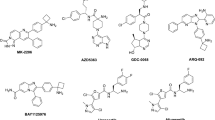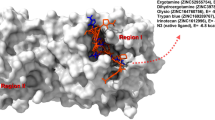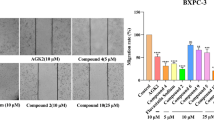Abstract
Understanding of the molecular mechanism and biological implication underlying the difference in binding of substrate peptides and small-molecule inhibitors to multidrug-resistant mutants of HIV-1 protease would help to develop new anti-HIV agents combating drug resistance. Here, an integration of rigorous quantum mechanics/molecular mechanics (QM/MM) analysis and empirical Poisson–Boltzmann/surface area (PB/SA) model is described to investigate the structural basis and energetic property of wild-type HIV-1 protease and its mutants in recognizing and binding with a wide variety of ligands, including the peptides derived from its cognate cleavage sites and the cleavage site variants as well as a number of FDA-approved protease inhibitors, attempting to explain why is substrate binding unsusceptible to most observed HIV-1 protease mutations. A preliminary test study demonstrates that the combined QM/MM–PB/SA scheme is able to effectively reproduce the relative ligand binding energy changes upon protease single- and double-mutations, albeit the absolute values appear to be different significantly between the calculated and experimental results. With the QM/MM–PB/SA calculations a complete mutation energy map of HIV-1 protease–ligand interactions is created, which unravels distinct affinity pictures of wild-type substrates, substrate variants and, particularly, the protease inhibitors bound to HIV-1 protease mutants, suggesting that, on the one hand, the evaluation pressure under anti-HIV chemotherapies addresses site-directed protease mutations that impair and undermine the intermolecular interactions specific to inhibitors but not substrates; on the other hand, co-evaluation of protease and its substrate peptides provides a more effective mechanism to avoid therapeutic surveillance. Further, nonbonded interaction analysis and computational alanine scanning reveal 12 key residues that is critical for substrate binding, from which the Asn25, Gly27, Ala28, Asp29 and Pro81 are identified that have not yet been found to cause drug resistance and hence would be the promising sites targeted by new protease inhibitors.





Similar content being viewed by others
References
Ali A, Reddy GS, Nalam MN, Anjum SG, Cao H, Schiffer CA, Rana TM (2010) Structure-based design, synthesis, and structure-activity relationship studies of HIV-1 protease inhibitors incorporating phenyloxazolidinones. J Med Chem 53:7699–7708
Bashford D, Case DA (2000) Generalized Born models of macromolecular solvation effects. Annu Rev Phys Chem 51:129–152
Berman HM, Westbrook J, Feng Z, Gilliland G, Bhat TN, Weissig H, Shindyalov IN, Bourne PE (2000) The protein data bank. Nucleic Acids Res 28:235–242
Beerenwinkel N, Sing T, Lengauer T, Rahnenfuhrer J, Roomp K, Savenkov I, Fischer R, Hoffmann D, Selbig J, Korn K, Walter H, Berg T, Braun P, Fatkenheuer G, Oette M, Rockstroh J, Kupfer B, Kaiser R, Daumer M (2005) Computational methods for the design of effective therapies against drug resistant HIV strains. Bioinformatics 21:3943–3950
Cornell WD, Cieplak P, Bayly CI, Kollman PA (1993) Application of RESP charges to calculate conformational energies, hydrogen bond energies, and free energies of solvation. J Am Chem Soc 115:9620–9631
Cornell WD, Cieplak P, Bayly CI, Gould IR, Merz KM Jr, Ferguson DM, Spellmeyer DC, Fox T, Caldwell JW, Kollman PA (1995) A second generation force field for the simulation of proteins, nucleic acids, and organic molecules. J Am Chem Soc 117:5179–5197
Clavel F, Hance AJ (2004) HIV drug resistance. N Engl J Med 350:1023–1035
de Oliveira T, Engelbrecht S, Janse van Rensburg E, Gordon M, Bishop K, zur Megede J, Barnett SW, Cassol S (2003) Variability at human immunodeficiency virus type 1 subtype C protease cleavage sites: an indication of viral fitness? J Virol 77:9422–9430
Dewar MJS, Zoebisch EG, Healy EF, Stewart JJP (1985) Development and use of quantum mechanical molecular models. 76. AM1: a new general purpose quantum mechanical molecular model. J Am Chem Soc 107:3902–3909
Duan Y, Wu C, Chowdhury S, Lee MC, Xiong GM, Zhang W, Yang R, Cieplak P, Luo R, Lee T, Caldwell J, Wang JM, Kollman P (2003) A point-charge force field for molecular mechanics simulations of proteins based on condensed-phase quantum mechanical calculations. J Comput Chem 24:1999–2012
Frisch MJ, Trucks GW, Schlegel HB, Scuseria GE, Robb MA, Cheeseman JR, Zakrzewski VG, Montgomery JA Jr, Stratmann RE, Burant JC, Dapprich S, Millam JM, Daniels AD, Kudin KN, Strain MC, Farkas O, Tomasi J, Barone V, Cossi M, Cammi R, Mennucci B, Pomelli C, Adamo C, Clifford S, Ochterski J, Petersson GA, Ayala PY, Cui Q, Morokuma K, Malick DK, Rabuck AD, Raghavachari K, Foresman JB, Cioslowski J, Ortiz JV, Stefanov BB, Liu G, Liashenko A, Piskorz P, Komaromi I, Gomperts R, Martin RL, Fox DJ, Keith T, Al-Laham MA, Peng CY, Nanayakkara A, Gonzalez C, Challacombe M, Gill PMW, Johnson BG, Chen W, Wong MW, Andres JL, Head-Gordon M, Replogle ES, Pople JA (2003) Gaussian 03. Gaussian Inc., Wallingford
Ghosh AK, Sridhar PR, Leshchenko S, Hussain AK, Li J, Kovalevsky AY, Walters DE, Wedekind JE, Grum-Tokars V, Das D, Koh Y, Maeda K, Gatanaga H, Weber IT, Mitsuya H (2006) Structure-based design of novel HIV-1 protease inhibitors to combat drug resistance. J Med Chem 49:5252–5261
Ghosh AK, Chapsal BD, Weber IT, Mitsuya H (2008) Design of HIV protease inhibitors targeting protein backbone: an effective strategy for combating drug resistance. Acc Chem Res 41:78–86
Gulnik SV, Suvorov LI, Liu B, Yu B, Anderson B, Mitsuya H, Erickson JW (1995) Kinetic characterization and cross-resistance patterns of HIV-1 protease mutants selected under drug pressure. Biochemistry 34:9282–9287
Guo X, He D, Liu L, Kuang R, Liu L (2012a) Use of QM/MM scheme to reproduce macromolecule–small molecule noncovalent binding energy. Comput Theor Chem 991:134–140
Guo X, He D, Huang L, Liu L, Liu L, Yang H (2012b) Strain energy in enzyme–substrate binding: an energetic insight into the flexibility versus rigidity of enzyme active site. Comput Theor Chem 995:17–23
Hou TJ, Yu R (2007) Molecular dynamics and free energy studies on the wild-type and double mutant HIV-1 protease complexed with amprenavir and two amprenavir-related inhibitors: mechanism for binding and drug resistance. J Med Chem 50:1177–1188
Hou T, McLaughlin WA, Wang W (2008) Evaluating the potency of HIV-1 protease drugs to combat resistance. Proteins 71:1163–1174
Hou T, Zhang W, Wang J, Wang W (2009) Predicting drug resistance of the HIV-1 protease using molecular interaction energy components. Proteins 74:837–846
Johnson VA, Calvez V, Gunthard HF, Paredes R, Pillay D, Shafer RW, Wensing AM, Richman DD (2013) Update of the drug resistance mutations in HIV-1: March 2013. Top Antivir Med 21:6–14
Kar P, Knecht V (2012) Energetic basis for drug resistance of HIV-1 protease mutants against amprenavir. J Comput Aided Mol Des 26:215–232
King NM, Prabu-Jeyabalan M, Nalivaika EA, Schiffer CA (2004) Combating susceptibility to drug resistance: lessons from HIV-1 protease. Chem Biol 11:1333–1338
Kovalevsky AY, Tie Y, Liu F, Boross PI, Wang YF, Leshchenko S, Ghosh AK, Harrison RW, Weber IT (2006) Effectiveness of nonpeptide clinical inhibitor TMC-114 on HIV-1 protease with highly drug resistant mutations D30N, I50V, and L90M. J Med Chem 49:1379–1387
Krivov GG, Shapovalov MV, Dunbrack RL Jr (2009) Improved prediction of protein side-chain conformations with SCWRL4. Proteins 77:778–795
Maschera B, Darby G, Palú G, Wright LL, Tisdale M, Myers R, Blair ED, Furfine ES (1996) Human immunodeficiency virus. Mutations in the viral protease that confer resistance to saquinavir increase the dissociation rate constant of the protease-saquinavir complex. J Biol Chem 271:33231–33235
Massova I, Kollman PA (1999) Computational alanine scanning to probe protein–protein interactions: a novel approach to evaluate binding free energies. J Am Chem Soc 121:8133–8143
Meher BR, Wang Y (2012) Interaction of I50V mutant and I50L/A71V double mutant HIV-protease with inhibitor TMC114 (darunavir): molecular dynamics simulation and binding free energy studies. J Phys Chem B 116:1884–1900
Ni Z, Jin X, Zhou P, Wu Q, Lin XF (2011a) A combination of computational and experimental approaches to investigate the binding behavior of B. sub Lipase A mutants with substrate pNPP. Mol Inf 30:359–367
Ni Z, Zhou P, Jin X, Lin XF (2011b) Integrating in silico and in vitro approaches to dissect the stereoselectivity of Bacillus subtilis lipase A toward ketoprofen vinyl ester. Chem Biol Drug Des 78:301–308
Ohtaka H, Schön A, Freire E (2003) Multidrug resistance to HIV-1 protease inhibition requires cooperative coupling between distal mutations. Biochemistry 42:13659–13666
Olsson MHM, Søndergaard CR, Rostkowski M, Jensen JH (2011) PROPKA3: consistent treatment of internal and surface residues in empirical pK a predictions. J Chem Theory Comput 7:525–537
Partaledis JA, Yamaguchi K, Tisdale M, Blair EE, Falcione C, Maschera B, Myers RE, Pazhanisamy S, Futer O, Cullinan AB (1995) In vitro selection and characterization of human immunodeficiency virus type 1 (HIV-1) isolates with reduced sensitivity to hydroxyethylamino sulfonamide inhibitors of HIV-1 aspartyl protease. J Virol 69:5228–5235
Rocchia W, Alexov E, Honig B (2001) Extending the applicability of the nonlinear Poisson–Boltzmann equation: multiple dielectric constants and multivalent ions. J Phys Chem B 105:6507–6514
Sasková KG, Kozísek M, Lepsík M, Brynda J, Rezácová P, Václavíková J, Kagan RM, Machala L, Konvalinka J (2008) Enzymatic and structural analysis of the I47A mutation contributing to the reduced susceptibility to HIV protease inhibitor lopinavir. Protein Sci 17:1555–1564
Senn HM, Thiel W (2009) QM/MM methods for biomolecular systems. Angew Chem Int Ed 48:1198–1229
Soares EAJM, Santos AFA, Sousa TM, Sprinz E, Martinez AMB, Silveira J, Tanuri A, Soares MA (2007) Differential drug resistance acquisition in HIV-1 of subtypes B and C. PLoS One 2:e730
Tian F, Yang L, Lv F, Luo X, Pan Y (2011a) Why OppA protein can bind sequence-independent peptides? A combination of QM/MM, PB/SA, and structure-based QSAR analyses. Amino Acids 40:493–503
Tian F, Lv Y, Zhou P, Yang L (2011b) Characterization of PDZ domain–peptide interactions using an integrated protocol of QM/MM, PB/SA, and CFEA analyses. J Comput Aided Mol Des 25:947–958
Velazquez-Campoy A, Muzammil S, Ohtaka H, Schön A, Vega S, Freire E (2003) Structural and thermodynamic basis of resistance to HIV-1 protease inhibition: implications for inhibitor design. Curr Drug Targets Infect Disord 3:311–328
Vreven T, Byun KS, Komáromi I, Dapprich S, Montgomery JA, Morokuma K, Frisch MJ (2006) Combining quantum mechanics methods with molecular mechanics methods in ONIOM. J Chem Theory Comput 2:815–826
Wang J, Morin P, Wang W, Kollman PA (2001) Use of MM-PBSA in reproducing the binding free energies to HIV-1 RT of TIBO derivatives and predicting the binding mode to HIV-1 RT of efavirenz by docking and MM-PBSA. J Am Chem Soc 123:5221–5230
Wang J, Wolf RM, Caldwell JW, Kollman PA, Case DA (2004) Development and testing of a general amber force field. J Comput Chem 25:1157–1174
Wainberg MA, Friedland G (1998) Public health implications of antiretroviral therapy and HIV drug resistance. JAMA 279:1977–1983
Weikl TR, Hemmateenejad B (2013) How conformational changes can affect catalysis, inhibition and drug resistance of enzymes with induced-fit binding mechanism such as the HIV-1 protease. Biochim Biophys Acta 1834:867–873
Word JM, Lovell SC, Richardson JS, Richardson DC (1999) Asparagine and glutamine: using hydrogen atom contacts in the choice of side-chain amide orientation. J Mol Biol 285:1735–1747
Zhou P, Zou J, Tian F, Shang Z (2009a) Fluorine bonding—how does it work in protein–ligand interactions? J Chem Inf Model 49:2344–2355
Zhou P, Tian F, Shang Z (2009b) 2D depiction of nonbonding interactions for protein complexes. J Comput Chem 30:940–951
Zhou P, Wang C, Ren Y, Yang C, Tian F (2013) Computational peptidology: a new and promising approach to therapeutic peptide design. Curr Med Chem 20:1985–1996
Acknowledgments
This work was supported by the National Natural Science Funds for Young Scholar (No. 31200602), the Jiangsu University for Advanced Professionals (No. 1281330021) and the China Postdoctoral Science Foundation (No. 2012M521001).
Conflict of interest
None.
Author information
Authors and Affiliations
Corresponding authors
Rights and permissions
About this article
Cite this article
Ni, Z., Chen, H., Qi, X. et al. Why is Substrate Peptide Binding Unsusceptible to Multidrug-Resistant Mutations in HIV-1 Protease? A Structural and Energetic Analysis. Int J Pept Res Ther 20, 43–51 (2014). https://doi.org/10.1007/s10989-013-9365-9
Accepted:
Published:
Issue Date:
DOI: https://doi.org/10.1007/s10989-013-9365-9




